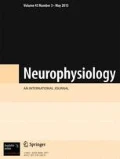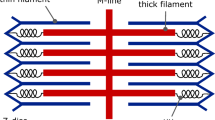Abstract
Advances in modern neuroscience require the identification of principles that connect different levels of experimental analysis, from molecular mechanisms to explanations of cellular functions, then to circuits, and, ultimately, to systems and behavior. Here, we examine how synaptic organization of the sympathetic ganglia may enable them to function as use-dependent amplifiers of preganglionic activity and how the gain of this amplification may be modulated by metabotropic signaling mechanisms. The approach combines a general computational model of ganglionic integration together with experimental tests of the model using the dynamic clamp method. In these experiments, we recorded intracellularly from dissociated bullfrog sympathetic neurons and then mimicked physiological synapses with virtual computer-generated synapses. It, thus, became possible to analyze the synaptic gain by recording cellular responses to complex patterns of synaptic activity that normally arise in vivo from convergent nicotinic and muscarinic synapses. The results of these studies are significant because they illustrate how gain generated through ganglionic integration may contribute to the feedback control of important autonomic behaviors, in particular to the control of the blood pressure. We dedicate this paper to the memory of Professor Vladimir Skok, whose rich legacy in synaptic physiology helped to establish the modern paradigm for connecting multiple levels of analysis in studies of the nervous system.
Similar content being viewed by others
References
K. Kuba and K. Koketsu, “Synaptic events in sympathetic ganglia,” Prog. Neurobiol., 11, 77–169 (1978).
V. Skok, Physiology of Autonomic Ganglia, Igaku Shoin, Tokyo (1973).
P. A. Smith, “Amphibian sympathetic ganglia: an owner’s and operator’s manual,” Prog. Neurobiol., 43, 439–510 (1994).
G. Gabella, Structure of the Autonomic Nervous System, Chapman and Hall, London (1976).
F. B. Wang, M. C. Holst, and T. L. Powley, “The ratio of pre-to postganglionic neurons and related issues in the autonomic nervous system,” Brain Res. Brain Res. Rev., 21, 93–115 (1995).
W. Jänig, The Integrative Action of the Autonomic Nervous System. Neurobiology of Homeostasis, Cambridge Univ. Press, Cambridge (2006).
S. Nishi, H. Soeda, and K. Koketsu, “Studies on sympathetic B and C neurons and patterns of preganglionic innervation,” J. Cell. Physiol., 66, 19–32 (1965).
J. P. Horn and W. D. Stofer, “Spinal origins of preganglionic B and C neurons that innervate paravertebral sympathetic ganglia nine and ten of the bullfrog,” J. Comp. Neurol., 268, 71–83 (1988).
B. Libet, S. Chichibu, and T. Tosaka, “Slow synaptic responses and excitability in sympathetic ganglia of the bullfrog,” J. Neurophysiol., 31, 383–395 (1968).
V. I. Skok, “Conduction in tenth ganglion of the frog sympathetic trunk,” Fed. Proc. Transl. Suppl., 24, 363–367 (1965).
P. R. Adams and D. A. Brown, “Synaptic inhibition of the M-current: slow excitatory post-synaptic potential mechanism in bullfrog sympathetic neurons,” J. Physiol., 332, 263–272 (1982).
W. X. Shen and J. P. Horn, “Presynaptic muscarinic inhibition in bullfrog sympathetic ganglia,” J. Physiol., 491, Part 2, 413–421 (1996).
T. Tosaka, S. Chichibu, and B. Libet, “Intracellular analysis of slow inhibitors and excitatory postsynaptic potentials in sympathetic ganglia of the frog,” J. Neurophysiol., 31, 396–409 (1968).
J. Dodd and J. P. Horn, “Muscarinic inhibition of sympathetic C neurons in the bullfrog,” J. Physiol., 334, 271–291 (1983).
L. Y. Jan and Y. N. Jan, “Peptidergic transmission in sympathetic ganglia of the frog,” J. Physiol., 327, 219–246 (1982).
Y. N. Jan, L. Y. Jan, and S. W. Kuffler, “A peptide as a possible transmitter in sympathetic ganglia of the frog,” Proc. Natl. Acad. Sci. USA, 76, 1501–1505 (1979).
P. Jobling and J. P. Horn, “In vitro relation between preganglionic sympathetic stimulation and activity of cutaneous glands in the bullfrog,” J. Physiol., 494, Part 1, 287–296 (1996).
R. Thorne and J. P. Horn, “Role of ganglionic cotransmission in sympathetic control of the isolated bullfrog aorta,” J. Physiol., 498, Part 1, 201–214 (1997).
M. J. Dennis, A. J. Harris, and S. W. Kuffler, “Synaptic transmission and its duplication by focally applied acetylcholine in parasympathetic neurons in the heart of the frog,” Proc. Roy. Soc. London, Ser. B, Biol. Sci., 177, 509–539 (1971).
J. Dodd and J. P. Horn, “A reclassification of B and C neurons in the ninth and tenth paravertebral sympathetic ganglia of the bullfrog,” J. Physiol., 334, 255–269 (1983).
H. C. Hartzell, S. W. Kuffler, R. Stickgold, and D. Yoshikami, “Synaptic excitation and inhibition resulting from direct action of acetylcholine on two types of chemoreceptors on individual amphibian parasympathetic neurons,” J. Physiol., 271, 817–846 (1977).
U. J. McMahan and S. W. Kuffler, “Visual identification of synaptic boutons on living ganglion cells and of varicosities in postganglionic axons in the heart of the frog,” Proc. Roy. Soc. London, Ser. B, Biol. Sci., 177, 485–508 (1971).
S. W. Jones, “Sodium currents in dissociated bull-frog sympathetic neurons,” J. Physiol., 389, 605–627 (1987).
S. W. Kuffler and T. J. Sejnowski, “Peptidergic and muscarinic excitation at amphibian sympathetic synapses,” J. Physiol., 341, 257–278 (1983).
S. Lei, W. F. Dryden, and P. A. Smith, “Regulation of N-and L-type Ca2+ channels in adult frog sympathetic ganglion B cells by nerve growth factor in vitro and in vivo,” J. Neurophysiol., 78, 3359–3370 (1997).
D. W. Wheeler, P. H. Kullmann, and J. P. Horn, “Estimating use-dependent synaptic gain in autonomic ganglia by computational simulation and dynamic-clamp analysis,” J. Neurophysiol., 92, 2659–2671 (2004).
S. Nishi and K. Koketsu, “Early and late after discharges of amphibian sympathetic ganglion cells,” J. Neurophysiol., 31, 109–121 (1968).
K. Koketsu, “Cholinergic synaptic potentials and the underlying ionic mechanisms,” Fed. Proc., 28, 101–112 (1969).
D. A. Brown and P. R. Adams, “Muscarinic suppression of a novel voltage-sensitive K+ current in a vertebrate neuron,” Nature, 283, 673–676 (1980).
D. A. Brown, S. A. Hughes, S. J. Marsh, and A. Tinker, “Regulation of M(Kv7.2/7.3) channels in neurons by PIP2 and products of PIP2 hydrolysis: significance for receptor-mediated inhibition,” J. Physiol., 582, 917–925 (2007).
A. Y. Ivanoff and P. A. Smith, “In vivo activity of B-and C-neurons in the paravertebral sympathetic ganglia of the bullfrog,” J. Physiol., 485, Part 3, 797–815 (1995).
V. I. Skok and A. Y. Ivanov, “What is the ongoing activity of sympathetic neurons?” J. Auton. Nerv. Syst., 7, 263–270 (1983).
P. Karila and J. P. Horn, “Secondary nicotinic synapses on sympathetic B neurons and their putative role in ganglionic amplification of activity,” J. Neurosci., 20, 908–918 (2000).
V. Skok, A. Ivanov, L. Tatarchenko, and V. Maslov, “Ganglionic neuronal mechanisms involved in circulatory control system,” Acta Neurobiol. Exp. (Wars.), 56, 107–115 (1996).
L. A. Tatarchenko, A. Ivanov, and V. I. Skok, “Organization of the tonically active pathways through the superior cervical ganglion of the rabbit,” J. Auton. Nerv. Syst., 30, Suppl, S163–S168 (1990).
E. M. McLachlan, P. J. Davies, H. J. Habler, and J. Jamieson, “On-going and reflex synaptic events in rat superior cervical ganglion cells,” J. Physiol., 501, Part 1, 165–181 (1997).
E. M. McLachlan, H. J. Habler, J. Jamieson, and P. J. Davies, “Analysis of the periodicity of synaptic events in neurons in the superior cervical ganglion of anaesthetized rats,” J. Physiol., 511, Part 2, 461–478 (1998).
D. Purves, E. Rubin, W. D. Snider, and J. Lichtman, “Relation of animal size to convergence, divergence, and neuronal number in peripheral sympathetic pathways,” J. Neurosci., 6, 158–163 (1986).
V. Yu. Maslov, A. Ya. Ivanov, and V. Skok, “Background activity of the rabbit superior cervical ganglion neurons: soundness of random hypothesis of its formation,” Neurophysiology, 28, No. 1, 36–40 (1996).
H. Schobesberger, B. S. Gutkin, and J. P. Horn, “A minimal model for metabotropic modulation of fast synaptic transmission and firing properties in bullfrog sympathetic B neurons,” Neurocomputing, 26/27, 255–262 (1998).
H. Schobesberger, D. W. Wheeler, and J. P. Horn, “A model for pleiotropic muscarinic potentiation of fast synaptic transmission,” J. Neurophysiol., 83, 1912–1923 (2000).
P. H. Kullmann, D. W. Wheeler, J. Beacom, and J. P. Horn, “Implementation of a fast 16-Bit dynamic clamp using LabVIEW-RT,” J. Neurophysiol., 91, 542–554 (2004).
P. H. Kullmann and J. P. Horn, “Excitatory muscarinic modulation strengthens virtual nicotinic synapses on sympathetic neurons and thereby enhances synaptic gain,” J. Neurophysiol., 96, 3104–3113 (2006).
C. Li and J. P. Horn, “Physiological classification of sympathetic neurons in the rat superior cervical ganglion,” J. Neurophysiol., 95, 187–195 (2006).
Author information
Authors and Affiliations
Corresponding author
Additional information
Neirofiziologiya/Neurophysiology, Vol. 39, No. 6, pp. 486–492, November–December, 2007.
Rights and permissions
About this article
Cite this article
Horn, J.P., Kullmann, P.H.M. Dynamic clamp analysis of synaptic integration in sympathetic ganglia. Neurophysiology 39, 423–429 (2007). https://doi.org/10.1007/s11062-008-9002-y
Published:
Issue Date:
DOI: https://doi.org/10.1007/s11062-008-9002-y




